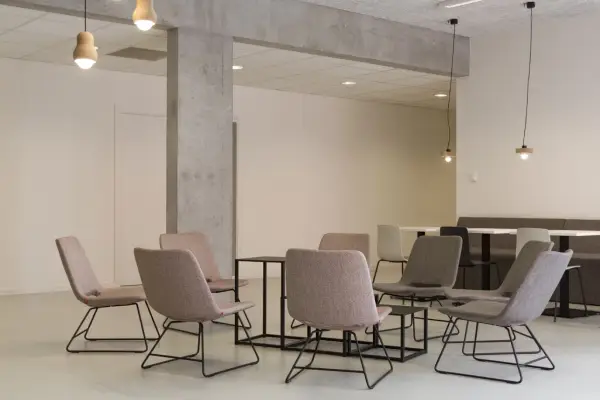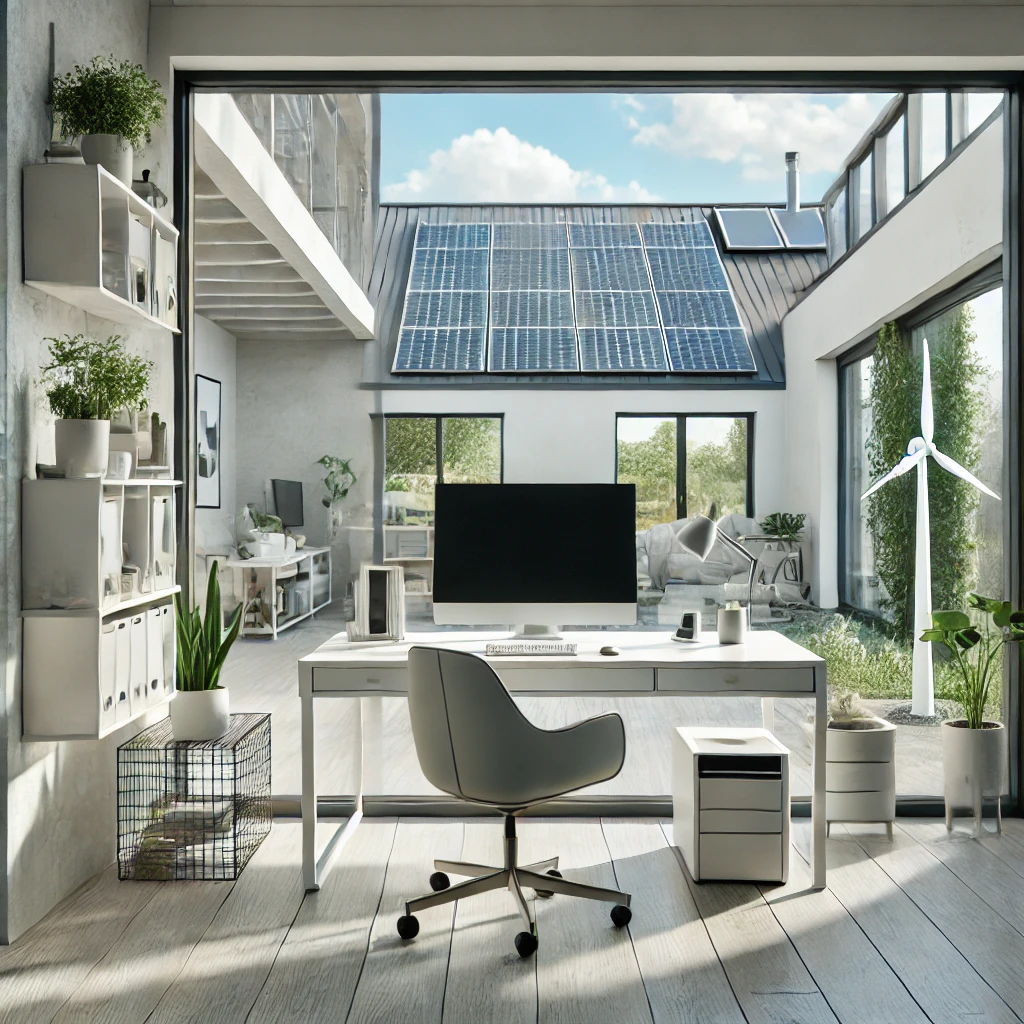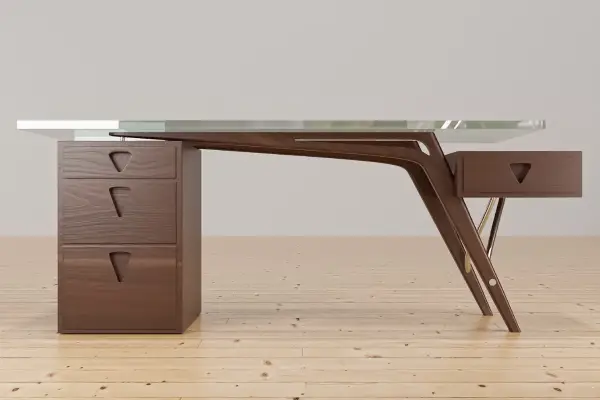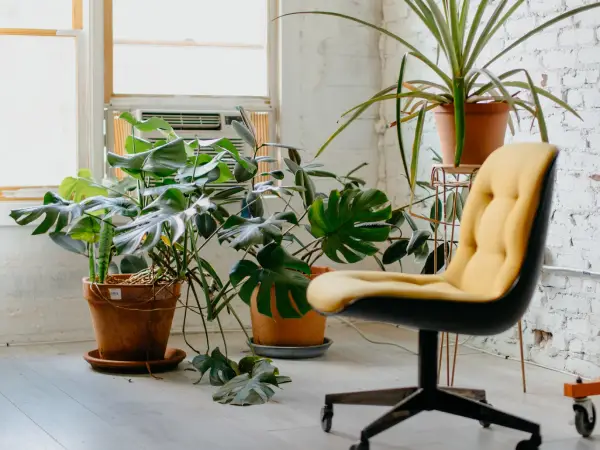In a world where we are constantly bombarded with information and distractions, creating a workspace that fosters focus and tranquility has never been more important. As we step into 2024, the trend of minimalist office design is taking the business world by storm, and for good reason. Modern minimalist office furniture isn’t just about aesthetics—it’s about creating an environment that enhances productivity, encourages creativity, and promotes well-being.
Imagine walking into an office where everything has its place, where clean lines and uncluttered surfaces greet you, and where every piece of furniture serves a purpose. This is the essence of modern minimalism. It’s a design philosophy that strips away the unnecessary, leaving behind only what is essential and functional. It’s about finding beauty in simplicity and creating a space that feels open and inviting.
In this article, we’ll explore the latest trends in minimalist office furniture for 2024. From sustainable materials to smart, multi-functional pieces, we’ll show you how to transform your workspace into a haven of productivity and style. Whether you’re setting up a home office or redesigning a corporate space, these trends will help you create an environment that not only looks good but also works well.
So, if you’re ready to embrace the power of simplicity and take your office design to the next level, read on. Discover how modern minimalist office furniture can change the way you work and feel every day. Welcome to the future of office design—welcome to modern minimalism.
Key Characteristics of Modern Minimalist Office Furniture
In the realm of office design, modern minimalism has emerged as a guiding star, leading us toward a workspace that embodies clarity, efficiency, and beauty. But what exactly defines minimalist office furniture? Let’s delve into the key characteristics that make this style both timeless and revolutionary.
Clean Lines and Simple Forms
At the heart of minimalist design are clean lines and simple forms. This means desks, chairs, and storage units that feature straight edges and unembellished surfaces. The goal is to create a sense of order and tranquility, eliminating visual clutter and allowing the mind to focus. Think of a sleek white desk with tapered legs, a chair with a streamlined silhouette, and shelving units that float effortlessly against the wall. These pieces not only look elegant but also contribute to a sense of calm and clarity in your workspace.
Neutral and Muted Color Palettes
When it comes to color, minimalism embraces a neutral palette. Whites, grays, and natural wood tones dominate, creating a soothing backdrop that promotes concentration and creativity. These muted colors are far from boring—they provide a canvas that highlights the beauty of natural materials and the play of light and shadow. Imagine a workspace bathed in soft, natural light, where each piece of furniture harmonizes with the next, creating a cohesive and serene environment.
Functional and Multi-purpose Pieces
In a minimalist office, every piece of furniture serves a purpose—and often, more than one. Multi-functional furniture is a hallmark of this design philosophy. Think of desks that double as storage units, chairs that can be easily moved and reconfigured for different tasks, and tables that can be adjusted for sitting or standing work. This focus on functionality ensures that every item in your office contributes to productivity and efficiency, making the most of your space without overwhelming it.
Quality Over Quantity
Minimalism is about curating, not cluttering. Instead of filling your office with numerous items, the emphasis is on selecting a few, high-quality pieces that will stand the test of time. Investing in well-crafted, durable furniture not only enhances the aesthetic of your workspace but also reduces the need for frequent replacements, making it a sustainable choice. Picture a beautifully crafted wooden desk, a comfortable ergonomic chair, and a few strategically placed storage solutions—each piece chosen for its durability, functionality, and aesthetic appeal.
As we continue to explore the modern minimalist office furniture trends for 2024, these key characteristics will serve as our foundation. They guide us toward creating spaces that are not only stylish and modern but also conducive to a productive and peaceful work environment. So, whether you’re redesigning a home office or revamping a corporate workspace, let these principles of minimalism inspire you to create a place where you can truly thrive.
Top Trends for 2024
As we embrace 2024, the world of office furniture design continues to evolve, with modern minimalism at the forefront. This year’s trends blend form and function, sustainability and technology, to create workspaces that are not only visually appealing but also enhance productivity and well-being. Let’s explore the top trends that are defining modern minimalist office furniture in 2024.
Sustainable Materials
Sustainability is no longer just a buzzword—it’s a necessity. In 2024, the minimalist office furniture landscape is dominated by eco-friendly materials. Designers are turning to recycled wood, bamboo, and reclaimed metal to create stunning pieces that are both beautiful and kind to the planet. Imagine a sleek desk made from reclaimed oak, paired with a chair crafted from recycled metal—each piece tells a story and contributes to a sustainable future.
Smart Furniture
In an increasingly digital world, smart furniture is revolutionizing our workspaces. These pieces seamlessly integrate technology with minimalist design. Think adjustable desks that remember your preferred height settings, ergonomic chairs with built-in posture sensors, and tables with wireless charging capabilities. This blend of technology and simplicity not only enhances functionality but also keeps your workspace clutter-free and efficient.
Modular Designs
Flexibility is key in modern office design, and modular furniture is leading the charge. These pieces can be easily reconfigured to adapt to changing needs, whether you’re working solo, collaborating with a team, or hosting clients. Imagine a modular desk system that can be rearranged to form individual workstations or a large conference table in minutes. This adaptability ensures your office remains functional and efficient, no matter the task at hand.
Invisible Storage Solutions
Minimalism thrives on the mantra “less is more,” and invisible storage solutions are a testament to this. These clever designs keep your office essentials out of sight, maintaining a clean and open look. Think hidden compartments within desks, under-desk drawers, and sleek wall-mounted cabinets that blend seamlessly into the background. These solutions ensure that your workspace remains uncluttered, promoting a sense of calm and order.
Organic Shapes and Textures
While minimalism often embraces clean lines and simplicity, 2024 sees a rise in organic shapes and textures to soften the aesthetic. Natural elements like wood grains, stone surfaces, and textured fabrics add warmth and character to minimalist designs. Imagine a workspace with a curvaceous wooden desk, a stone-topped table, and soft, textured chairs. These elements bring a touch of nature indoors, creating a balanced and inviting environment.
As we look forward to the year ahead, these trends are set to redefine how we think about office furniture and design. Sustainable materials, smart technology, modular designs, invisible storage, and organic textures are not just trends—they’re a blueprint for creating workspaces that are functional, flexible, and inspiring. Embrace these trends in 2024, and transform your office into a minimalist haven where productivity and creativity can flourish.
Popular Pieces in 2024
In the dynamic world of office design, certain furniture pieces stand out, embodying the principles of modern minimalism while offering unparalleled functionality and style. As we step into 2024, here are the must-have items that are redefining workspaces everywhere.
Standing Desks
Health and productivity go hand in hand, and standing desks are at the forefront of this movement. These adjustable desks allow you to switch between sitting and standing positions throughout the day, promoting better posture, increased energy levels, and reduced risk of sedentary-related health issues. Imagine a sleek, height-adjustable desk with a minimalist design—clean lines, neutral tones, and just the right amount of space for your essentials. Standing desks are not just a trend; they are a revolution in creating healthier, more dynamic work environments.
Ergonomic Chairs
Comfort is crucial for productivity, and ergonomic chairs are designed with this in mind. In 2024, these chairs are more stylish and minimalist than ever before. Think of a chair with a streamlined silhouette, crafted from high-quality materials, and featuring advanced ergonomic adjustments. These chairs support your posture, reduce strain on your back and neck, and enhance your overall comfort, allowing you to focus on your work without distractions.
Compact Storage Units
Clutter is the enemy of minimalism, and compact storage units are here to help. These sleek cabinets and drawers are designed to maximize storage while maintaining a clean, unobtrusive look. Picture a low-profile storage unit that fits seamlessly under your desk, or a wall-mounted cabinet that blends effortlessly into the background. These storage solutions keep your workspace tidy and organized, ensuring that everything you need is within reach but out of sight.
Minimalist Lighting
Lighting plays a crucial role in setting the mood and enhancing the functionality of your workspace. In 2024, minimalist lighting solutions are all about simplicity and elegance. Think of sleek desk lamps with adjustable arms, pendant lights with clean lines, and floor lamps that provide soft, diffused light. These lighting options not only illuminate your workspace effectively but also add a touch of modern sophistication to your office decor.
Multi-functional Tables
Versatility is a key component of modern minimalist design, and multi-functional tables are the epitome of this principle. These tables can be used for a variety of purposes—meetings, collaborative work, individual tasks, or even as standing desks. Imagine a table with a minimalist design that can be easily adjusted for height, or a modular table system that can be reconfigured to suit different needs. These multi-functional tables ensure that your office space remains flexible and adaptable, no matter what the day brings.
As you look to update your office in 2024, consider incorporating these popular pieces. Each one not only aligns with the principles of modern minimalism but also enhances the functionality and aesthetic of your workspace. Standing desks, ergonomic chairs, compact storage units, minimalist lighting, and multi-functional tables are more than just furniture—they are the building blocks of a productive, stylish, and efficient office environment. Embrace these pieces, and watch your workspace transform into a minimalist masterpiece.
Incorporating Minimalist Furniture in Various Office Settings
Modern minimalist office furniture isn’t just a trend—it’s a versatile design approach that can transform any workspace into a haven of productivity and tranquility. Whether you’re working from home, in a corporate environment, or sharing space in a co-working hub, minimalist furniture can be tailored to fit your unique needs. Here’s how you can incorporate minimalist designs into different office settings in 2024.
Home Offices
Creating a minimalist home office is all about making the most of your space while maintaining a sense of order and calm. Start by choosing a sleek, functional desk that fits your work style—perhaps an adjustable standing desk or a compact writing desk with hidden storage compartments. Pair it with an ergonomic chair that offers comfort without sacrificing style.
Incorporate floating shelves to keep essentials within reach without cluttering your workspace. Opt for neutral colors and natural materials to create a serene environment. Lighting is crucial in a home office; a minimalist desk lamp or wall-mounted light can provide adequate illumination without overwhelming the space. Remember, less is more—focus on quality pieces that serve multiple purposes and keep your home office free of unnecessary items.
Corporate Offices
In a corporate setting, the challenge is often to create a cohesive design that caters to various needs and promotes collaboration while maintaining individual productivity. Modular furniture is a perfect solution, offering flexibility and adaptability. Modular desks and storage units can be easily reconfigured to accommodate different team sizes and project needs.
Use partitions and minimalist room dividers to create distinct zones for focused work, meetings, and collaboration. Choose ergonomic chairs and adjustable desks to ensure comfort and promote healthy work habits across the office. Incorporate minimalist conference tables and comfortable seating in meeting rooms, keeping the design consistent with the overall minimalist aesthetic.
Storage solutions should be discreet yet functional—think of built-in cabinets or under-desk drawers that keep the workspace tidy. Incorporating biophilic elements, such as plants and natural light, can enhance the minimalist design and improve employee well-being.
Co-working Spaces
Co-working spaces are all about flexibility and community, and minimalist design can enhance these aspects. Opt for versatile, multi-functional furniture that can be easily moved and reconfigured. Long communal tables, adjustable desks, and stackable chairs allow members to customize their workspace according to their needs.
Use neutral colors and simple, clean lines to create a welcoming environment that appeals to a diverse range of users. Incorporate various seating options—comfortable lounge areas for informal meetings, ergonomic chairs for focused work, and standing desks for those who prefer to work on their feet.
Storage solutions in co-working spaces should be both practical and inconspicuous. Lockers or personal storage units that blend seamlessly with the overall design can keep personal belongings secure without disrupting the minimalist aesthetic.
Lighting plays a significant role in co-working spaces. Use a combination of natural light, task lighting, and ambient lighting to create a bright, inviting atmosphere. Minimalist lighting fixtures, such as pendant lights and floor lamps, can add a touch of elegance without overwhelming the space.
Conclusion
No matter the setting, incorporating minimalist furniture into your office can enhance both functionality and aesthetics. In home offices, focus on creating a serene and efficient space with multi-functional furniture and neutral tones. In corporate offices, use modular designs to promote flexibility and collaboration while maintaining a cohesive look. In co-working spaces, prioritize versatility and community with adaptable furniture and inviting designs. By embracing minimalist principles, you can transform any workspace into a productive, stylish, and inspiring environment.
Benefits of Minimalist Office Furniture
The minimalist approach to office furniture goes beyond aesthetics—it’s a philosophy that impacts productivity, well-being, and the overall work environment. Here are some compelling benefits of incorporating minimalist office furniture into your workspace.
Enhanced Focus and Productivity
Minimalist office furniture creates an environment free from distractions. By eliminating clutter and unnecessary items, you can focus better on the tasks at hand. Clean lines and simple designs promote a sense of order and tranquility, which can help reduce stress and enhance concentration. Imagine working at a desk where everything you need is within reach, yet there’s ample space to spread out and think clearly. This clarity can significantly boost your productivity and efficiency.
Aesthetically Pleasing
Minimalist furniture exudes a timeless elegance that can elevate any workspace. The use of neutral color palettes, natural materials, and sleek designs creates a visually appealing environment that feels both modern and inviting. This aesthetic appeal can have a positive impact on your mood and motivation. Walking into a beautifully designed office can inspire creativity and make you feel more connected to your work.
Easy Maintenance
One of the practical benefits of minimalist office furniture is its ease of maintenance. Fewer pieces of furniture mean less to clean and maintain. Simple designs with smooth surfaces are easier to dust and wipe down, helping you keep your workspace tidy with minimal effort. This simplicity extends to organization as well—discreet storage solutions ensure that everything has its place, making it easier to keep your office orderly and clutter-free.
Flexible and Adaptable
Minimalist office furniture is often designed with versatility in mind. Multi-functional pieces and modular designs can adapt to changing needs and different work styles. Whether you need to reconfigure your desk setup for a new project, create collaborative spaces for team meetings, or switch from sitting to standing during the day, minimalist furniture can accommodate these changes effortlessly. This flexibility ensures that your workspace remains functional and efficient, no matter what challenges come your way.
Promotes Well-being
A clutter-free environment can significantly impact your mental and physical well-being. Minimalist office furniture encourages a more organized and serene workspace, reducing stress and creating a sense of calm. Ergonomic designs ensure that your furniture supports healthy posture and reduces physical strain, contributing to your overall health. Additionally, minimalist designs often incorporate natural elements like wood and plants, which can enhance your connection to nature and improve your mood.
Conclusion
The benefits of minimalist office furniture are clear—enhanced focus and productivity, aesthetic appeal, easy maintenance, flexibility, and improved well-being. By adopting a minimalist approach, you can create a workspace that not only looks great but also supports your professional and personal growth. Whether you’re redesigning your home office, revamping a corporate space, or setting up a co-working area, minimalist furniture offers a timeless solution that adapts to your needs and helps you thrive. Embrace the power of simplicity and watch as your workspace transforms into a sanctuary of productivity and style.
Case Studies/Examples
To truly understand the impact of modern minimalist office furniture, let’s look at some real-life examples of companies and individuals who have embraced these trends. These case studies highlight how minimalist design principles can be applied in various settings, from tech startups to creative agencies and remote workspaces.
Tech Startups: The Case of Spark Innovations
Spark Innovations, a fast-growing tech startup, recognized the need for a workspace that could keep pace with its dynamic environment. They opted for a minimalist design, incorporating standing desks, ergonomic chairs, and modular furniture to create a flexible and functional office.
Standing Desks: Employees appreciated the option to switch between sitting and standing, which improved their overall well-being and energy levels. The clean lines and sleek designs of the desks contributed to a clutter-free environment that enhanced focus and productivity.
Modular Furniture: The ability to reconfigure workspaces quickly allowed teams to collaborate more effectively on projects. This adaptability was crucial for a startup where project requirements often change rapidly.
The minimalist approach helped Spark Innovations create an agile, productive, and aesthetically pleasing workspace that could adapt to their evolving needs.
Creative Agencies: Designing for Inspiration at Bright Ideas Studio
Bright Ideas Studio, a leading creative agency, sought to design a workspace that would inspire creativity while maintaining a professional and organized atmosphere. They achieved this by integrating minimalist furniture that emphasized both form and function.
Ergonomic Chairs and Multi-functional Tables: The use of comfortable, stylish ergonomic chairs and versatile tables allowed employees to work comfortably and creatively, whether they were brainstorming in groups or working individually.
Invisible Storage Solutions: By incorporating storage that blended seamlessly into the office design, Bright Ideas Studio maintained a clean and uncluttered workspace. This approach not only improved the visual appeal of the office but also made it easier for employees to find and store materials efficiently.
The result was a workspace that fostered creativity and collaboration, making it a favorite among employees and clients alike.
Remote Workspaces: The Home Office of Designer Lily Carter
Lily Carter, a freelance graphic designer, transformed her home office into a minimalist haven that maximized productivity and comfort. Her approach serves as an excellent example for remote workers looking to create an efficient and inspiring workspace at home.
Compact Storage Units: Lily used sleek, low-profile storage units to keep her work materials organized and out of sight. This kept her desk clear and allowed her to maintain a clutter-free environment that helped her focus on her creative work.
Minimalist Lighting: She incorporated a minimalist desk lamp and wall-mounted light fixtures to provide ample illumination without overwhelming her small office space. The soft, diffused light created a warm and inviting atmosphere conducive to long hours of creative work.
Lily’s minimalist home office not only enhanced her productivity but also provided a serene space where she could find inspiration and focus.
Conclusion
These case studies illustrate how modern minimalist office furniture can transform different types of workspaces. Whether it’s a tech startup needing flexibility, a creative agency seeking inspiration, or a remote worker designing a functional home office, minimalist design principles can be tailored to meet diverse needs. By focusing on clean lines, functional pieces, and uncluttered environments, these examples show how minimalist furniture can create spaces that are both beautiful and highly effective. Consider how you can apply these principles to your own workspace and experience the benefits of minimalist design firsthand.
Tips for Adopting Modern Minimalist Trends
Embracing modern minimalist office furniture can transform your workspace into a beacon of productivity, efficiency, and style. Whether you’re starting from scratch or revamping an existing setup, these tips will help you adopt minimalist trends seamlessly.
Declutter First
Before you introduce any new furniture, start by decluttering your current space. Remove items that are no longer needed, used, or contribute to visual clutter. This process is essential for creating a clean slate and helps you identify what is truly necessary. Consider the principles of “less is more” and keep only the items that add value to your workspace.
Invest in Key Pieces
Minimalism is about quality over quantity. Invest in a few high-quality, functional pieces that will stand the test of time. Look for ergonomic chairs, adjustable desks, and versatile storage solutions that meet your needs and complement the minimalist aesthetic. These pieces should be well-crafted, durable, and visually appealing.
Stay True to the Aesthetic
Consistency is key in minimalist design. Stick to a neutral color palette, such as whites, grays, and natural wood tones. Choose furniture with clean lines and simple forms to maintain a cohesive look. Avoid excessive decoration and focus on the beauty of simplicity. By adhering to these design principles, you’ll create a harmonious and visually pleasing workspace.
Use Natural Light
Natural light is a fundamental element of minimalist design. Maximize the use of natural light in your workspace by positioning your desk near windows and using light, airy window treatments. Natural light not only enhances the minimalist aesthetic but also boosts your mood and productivity. If natural light is limited, opt for minimalist lighting solutions, such as sleek desk lamps and floor lamps, that provide ample illumination without overwhelming the space.
Incorporate Greenery
Plants can add a touch of nature to your minimalist office, bringing life and freshness to the space. Choose low-maintenance plants that thrive indoors, such as succulents, snake plants, or pothos. Use simple, elegant planters that complement your office decor. Greenery can enhance the aesthetic appeal of your workspace while also improving air quality and reducing stress.
Optimize Storage Solutions
Effective storage is crucial in maintaining a minimalist office. Use hidden storage solutions, such as under-desk drawers, wall-mounted cabinets, and floating shelves, to keep your essentials organized and out of sight. This approach helps maintain a clean and uncluttered workspace, allowing you to focus on your work without distractions.
Focus on Functionality
Every piece of furniture in a minimalist office should serve a purpose. Choose multi-functional furniture that can adapt to different tasks and needs. For example, consider a desk that can be adjusted for sitting or standing, or a table that can be used for both individual work and collaborative meetings. This focus on functionality ensures that your workspace remains versatile and efficient.
Conclusion
Adopting modern minimalist trends in your office is more than just a design choice—it’s a commitment to creating a space that enhances productivity, promotes well-being, and exudes timeless style. By decluttering, investing in key pieces, maintaining a consistent aesthetic, maximizing natural light, incorporating greenery, optimizing storage solutions, and focusing on functionality, you can transform your workspace into a minimalist haven. Embrace these tips and experience the benefits of a clean, efficient, and inspiring office environment.
Conclusion: Embracing the Future of Office Design
As we navigate the ever-evolving landscape of work, the importance of creating a conducive, inspiring workspace has never been more apparent. The trends in modern minimalist office furniture for 2024 are more than just a fleeting design preference—they represent a shift towards environments that prioritize well-being, efficiency, and sustainability.
The Power of Simplicity
Minimalist office furniture embodies the philosophy of simplicity and functionality. By stripping away the non-essential, minimalist design creates spaces that are not only aesthetically pleasing but also incredibly practical. The clean lines, neutral color palettes, and functional pieces help reduce visual clutter, which can significantly enhance focus and productivity.
Adapting to Change
The trends we’ve explored—sustainable materials, smart furniture, modular designs, invisible storage solutions, and organic shapes and textures—demonstrate how modern minimalism adapts to the changing needs of today’s work environments. Whether you’re working from home, in a bustling corporate office, or a dynamic co-working space, minimalist furniture offers versatile solutions that can evolve with you.
Benefits Beyond Design
The benefits of adopting minimalist office furniture extend beyond mere aesthetics. Enhanced focus, improved productivity, and a boost in overall well-being are just a few of the advantages. Ergonomic designs promote better posture and comfort, reducing the physical strain of long work hours. Sustainable materials and designs reflect a commitment to the environment, aligning your workspace with broader global values.
Real-world Inspirations
From tech startups like Spark Innovations to creative agencies such as Bright Ideas Studio, and even individual home offices, the real-world examples we’ve explored show how different entities have successfully integrated minimalist design principles. These case studies highlight the adaptability and benefits of minimalist furniture in various contexts, providing practical inspiration for your own workspace transformation.
Practical Steps to Get Started
As you consider incorporating these trends into your office, remember to start with a clear plan. Declutter your space, invest in high-quality key pieces, and stay true to a neutral, cohesive aesthetic. Maximize natural light, add greenery, and focus on optimizing storage solutions. Most importantly, ensure every piece of furniture serves a functional purpose, enhancing the overall efficiency of your workspace.
Looking Ahead
The future of office design is here, and it’s minimalist. By embracing these trends, you are not only enhancing the look and feel of your workspace but also creating an environment that supports your professional and personal growth. The shift towards modern minimalist office furniture is a step towards a more productive, sustainable, and aesthetically pleasing work environment.
So, as you look to 2024 and beyond, consider how you can transform your office with these modern minimalist trends. Embrace the simplicity, the functionality, and the elegance of minimalist design, and watch as your workspace becomes a true reflection of efficiency and style.






